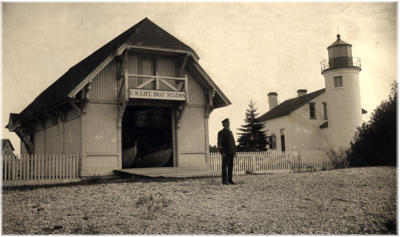|  |
Beaver Island's Harbor Light
The second of Beaver Island's lighthouses was built in 1856 at Whiskey Point, so called because the first white habitation was clustered around a trading post built here eighteen years earlier that made its profit by swapping provisions, particularly whiskey, and weak whiskey at that, for the produce gleaned from this archipelago. Paradise Bay had supplanted Mackinac Island as the economic center of Michigan's northwest a few years before (because cordwood was a dollar less on the dock here, not needing to be imported from the mainland), and this fine natural harbor quickly became a regular stopping and refueling point for lake traffic between Chicago and Buffalo. Added to that, the fishermen, fish buyers and shippers of sawmill products out and basic supplies in, filled the harbor with dozens of boats arriving and departing every day. The frequent marginal weather that affected those times as much as ours, particularly the fog, made the building of a lighthouse here a high priority.
A taller tower (41') was built in 1870 (partially because the mortar in the first tower was defective), and a sequence of keepers took up residence. Peter McKinley, reputed nephew of the President, was the second, followed by Clement Van Riper, who died trying to save the crew of the Thomas Howland. His doughty widow, Elizabeth Whitney, author of the memoir of Mormon times, Child of the Sea, was chosen to take his place. Keeping the flickering flame going in this pre-electric era was a daunting but necessary task. The last keeper, Emil Winter, was allowed to live on with his wife in the keeper's house after the light was automated and his service was no longer required. Before WWI his son from a secret, forgotten marriage in Germany showed up on Beaver Island and was put in the local school, but, speaking neither English nor Gaelic, did not fit in and left after two years.
 |
In 1874 Congress created the Life Saving Service, a precursor to the Coast Guard. At first this was a loosely organized group of volunteers (who received $10 for each life they saved) who responded to a shrill whistle by rushing to Beacon Point and pushing off into the storm or gale in a small boat. Despite their lack of formal training, these hearty souls were natural sailors who defied extreme dangers time and again to save those in distress. Their territory ranged from the little islands northwest of Garden to South Fox, but many of their most dramatic activities occurred right in the harbor, where fifty ships or more might seek protection from a storm. Captain Owen Gallagher was in charge, followed by former Mormon "Tip" Miller, the man who saved the Martin brothers. At times both of them had to designate a crew on the spot from the available fishermen, but despite the difficulties not a man was lost, neither sailor nor savior, for the last quarter of the Nineteenth Century.
In 1915 the Life-Saving Service was merged with other agencies to form the Coast Guard, which expanded and regularized its role on Beaver Island. Some of the Islanders enlisted in the ten- to twelve-man crew, and some of the others married local girls. John Andy Gallagher, who joined in 1934 and was stationed at Beaver Head, told stories such as sailing to Boulder Reef to take thirty people off the floundering Eugene J Buffington in a June storm, including the Captain's sobbing wife, before she could split in two. In 1939 the Lighthouse Service, which had maintained light ships on Gray's Reef, Lansing Shoals (where Johnny Andy's father, Andy, was stationed), and at North Manitou Island, was added to the Coast Guard. Archie LaFreniere, another Islander who served for three years, did not elaborate the good times when the light ship crews came here on liberty during Prohibition; suffice it to say that the Island has a long tradition of defying laws imposed from outside.
 |
The Coast Guards boarded at the Larsons, walking for their meals towards the center of the harbor from the north just as the Christian Brothers would walk towards the center from the south. The Coast Guard also acted as the fire department, going all over the Island to put out a blaze. They built an elevated look-out station at Sucker Point for watching the Garden Island channel. When Clarence Maudrie's tug got stuck in the ice for a week, the Coast Guard spotted him and let his wife know he had not drowned. The "Island Phone" was at the Coast Guard Station; in an emergency, that's where people went to get or give news. No matter what else was going on, though, when the call to help came "they had to go with no guarantee they'd return," as Johnny Andy said. Because of their jaunty friendliness and heroism they were an important part of this community for a long time, just as the light in the tower became an important symbol of the safety of home and hearth to many generations of Beaver Islanders. We are indeed lucky that our local government has stepped in to insure the continued shining of this cherished beacon. See Also:
1940 Harbor Light
Harbor Light Historic Property Lease
Harbor Light 1998 Photo
Beaver Island Head Lighthouse |


